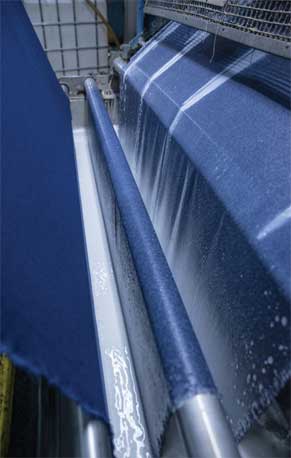
The ECO-Processing revolution is here!
Companies are now actively seeking more environmentally-friendly approaches to finish their fabric.
The textile industry ranks as the second most polluting sector globally. Synthetic dyes play a significant role in this pollution, responsible for nearly 20 per cent of the world’s water pollution linked to textile dyeing processes. This issue arises primarily due to the usage of non-biodegradable petroleum-based colorants, toxic agents to fix the colorants on textiles, and the subsequent release of these substances into the environment.
Companies all around the globe are taking decisive action by closing down most of the companies producing synthetic textile dyes following the implementation of stringent legislation. Consequently, companies are now actively seeking more environmentally-friendly approaches to finish their fabric. One promising alternative to synthetic colorants lies in the use of natural dyes extracted from biodegradable plant sources. However, even with this solution, toxic fixation agents are still necessary. As a result, both the textile and fashion industries are diligently exploring alternative methods of colouring fabrics.
Waterless technologies
The dyeing process varies based on the fabric type. Cotton dyeing, in particular, is a lengthier and more water and heat-intensive process due to the negative surface of cotton fibres. Consequently, cotton usually only absorbs around 75 per cent of the dye used, leading to the need for repetitive washing and heating of dyed fabric or yarn, resulting in significant wastewater generation.
However, some companies have adopted a technology that pre-treats cotton before spinning, making the dyeing process faster and reducing water usage by 90 per cent, energy consumption by 75 per cent, and the need for 90 per cent fewer chemicals to achieve effective dyeing of cotton.
On the other hand, dyeing synthetic fibres, like polyester, is generally a shorter process with high dye fixation rates (99 per cent or more of the applied dye is taken up by the fabric). Nonetheless, current dyeing practices may not be as sustainable. An alternative technique involves using dispersed dyes applied to a paper carrier. The dye is transferred from the paper to the textile’s surface using heat alone, which colours the dye at a molecular level. The paper used in this process is recyclable, and it reduces water usage by 90 per cent and energy consumption by 85 per cent, as the textiles do not require repetitive soaking and heat drying.
Extracting pigments from microbes
Currently, most of our clothing is dyed using synthetic dyes, which rely on valuable raw materials like crude oil in their production and often contain toxic chemicals harmful to both the environment and our health. While natural dyes are a less toxic alternative, they still necessitate agricultural land and the use of pesticides for cultivating dye-producing plants.
Labs around the globe have made a remarkable discovery in the realm of clothing coloration: using bacteria. One such microbe, Streptomyces coelicolor, undergoes a natural colour change based on the pH of its growth medium. By manipulating its environment, scientists can precisely determine the color it produces. The process of dyeing with bacteria involves several steps. Initially, the textile is autoclaved to prevent any contamination. Next, a liquid medium containing bacterial nutrients is poured over the textile in a container. The textile absorbs the medium and is then exposed to the bacteria. The entire setup is placed in a climate-controlled chamber for a few days, during which the live bacteria dyes the material. Following this, the textile is rinsed and gently laundered to remove any trace of the bacterial medium odour and then left to dry. The advantage of using bacterial dyes lies in their reduced water consumption compared to conventional dyes. Moreover, they offer a wide array of colours and can be used to dye various patterns effectively.
Emerging startups
In recent years, the textile industry has witnessed a remarkable transformation with the emergence of a handful of innovative startups dedicated to dyeing, processing, and finishing. Traditionally, this sector has been slow to adopt cutting-edge technologies and sustainable practices, but these pioneering startups are challenging the status quo and revolutionising the way textiles are produced. Leveraging advancements in nanotechnology, biotechnology, and automation, these companies are tackling long-standing challenges in the industry and paving the way for a more sustainable and efficient future.
One area where startups have made a significant impact is in eco-friendly dyeing processes. Conventional textile dyeing often involves the use of harmful chemicals and excessive water consumption, leading to significant environmental consequences. However, these startups are harnessing the power of biodegradable and non-toxic dyes, reducing water waste, and minimising their carbon footprint. As a result, they are not only reducing the environmental impact of textile production but also meeting the growing consumer demand for eco-conscious products.
Moreover, these startups are embracing digitalisation and automation to streamline processing and finishing techniques. By incorporating smart manufacturing processes, they can optimise production schedules, reduce human error, and improve overall efficiency. This increased efficiency allows for faster turnaround times and greater flexibility in meeting customer demands.
Furthermore, many of these startups are placing a strong emphasis on transparency and traceability throughout the supply chain. They are utilising blockchain technology and sophisticated tracking systems to ensure that every step of the production process is accountable and verifiable. This commitment to transparency builds trust with consumers and encourages responsible sourcing practices throughout the industry.
The Road Ahead
There is still work ahead of us to ensure the success and growth of the startups and technologies in the commercial sphere. Crucially, we need to foster investments and partnerships between the emerging companies and well-established fashion and chemicals companies.
Without such investments and collaborations, these new technologies cannot reach a level of economic viability that would entice fashion brands to adopt them. For a genuine commitment to sustainable dyeing practices that conserve valuable resources and protect the environment, it is vital to maintain the necessary alliances.



